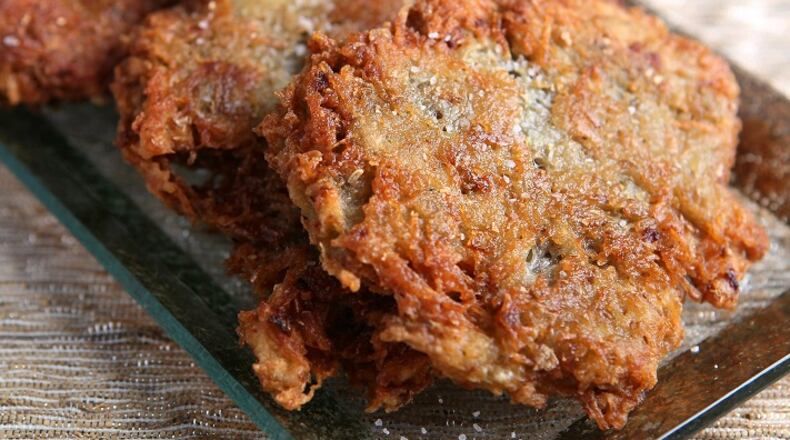Hanukkah commemorates the 2nd century BCE uprising of the rebellious Jewish Maccabees against King Antiochus IV Epiphanes. The victorious Maccabees returned to the Temple in Jerusalem to find it desecrated. The king’s troops had defiled all but one of the sealed containers of sacred olive oil used to keep the branched candelabrum, the menorah, burning day and night. The so-called “miracle of the oil” is that one container, only enough for one day, burned for eight, enabling the Jews to restore the Temple and obtain more sacred oil.
To celebrate the miraculous qualities of that olive oil, Jews traditionally fry Hanukkah foods. In the Ashkenazic tradition, celebrants fry that most ubiquitous Eastern European vegetable, the potato, and end up with latkes, potato pancakes. Jews from the Sephardic tradition fry up soufganiyot, jelly-filled doughnuts.
Olive oil, the star of the biblical story, has a reputation as a poor medium for frying. While it won’t stand up to the rigors of commercial use, extra-virgin olive oil will hold up fine frying a few dozen latkes. (Don’t use your best-quality extra-virgin oil here; the heat will destroy its subtleties.)
The two secrets to latke success are having the driest possible batter and the steadiest possible heat. To ensure a dry batter, wring the grated potatoes and onions in a dish towel. To ensure steady heat, use a large, heavy skillet (cast iron is ideal), use plenty of oil (hey, it’s Hanukkah), and don’t fry too many latkes at once.
———
POTATO LATKES
Latkes are best eaten right out of the frying pan. A close second is latkes made within the hour, blotted briefly on a plate lined with paper towels and kept warm in a very low (200-degree) oven on a baking sheet (in one layer).
2 large baking potatoes, peeled
1 large yellow onion, peeled and quartered
1 large egg
1 tablespoon matzo meal or flour
1 teaspoon salt
Olive oil or vegetable oil
1. Grate the onion and potato on the largest holes of the box grater, with the grating disc of the food processor, or with a v-slicer or mandoline. Place grated onion and potato in the middle of a clean, dry kitchen towel, gather up the ends of the towel and twist to squeeze out as much moisture as you can.
2. Lightly beat egg and combine with matzo meal or flour and salt. Toss with the squeezed potato and onion.
3. Pour about 1/4 inch of oil into a wide, heavy skillet over medium-high heat. Get the oil good and hot: a piece of potato introduced to the oil should sizzle and start to brown but should not burn. Using a 1/4-cup measure, scoop batter into the pan, forming it into a 1/2-inch-thick disc. Repeat, forming 4 pancakes, or as many as comfortably fit without crowding the pan. Cook until brown and crisp on the undersides, flip and cook until again brown on the undersides, for a total of 6 to 8 minutes. You may have to adjust the heat on the first batch so that the inside of the latke is cooked through at the same time that the outside achieves a nice brown crust.
4. Transfer cooked latkes to a nonstick baking sheet (or one lined with parchment) and keep warm in a 200-degree oven until serving, but preferably for no more than an hour.
5. Add more oil to the pan as needed and repeat until you have fried all the batter. Makes about a dozen latkes. Recipe may be doubled, tripled or quadrupled.
About the Author

